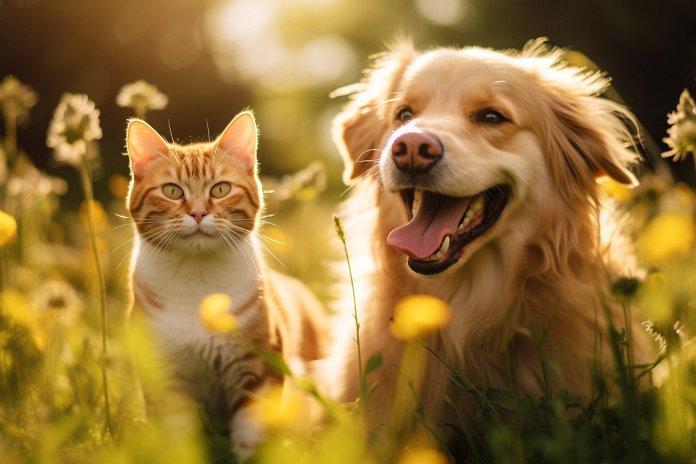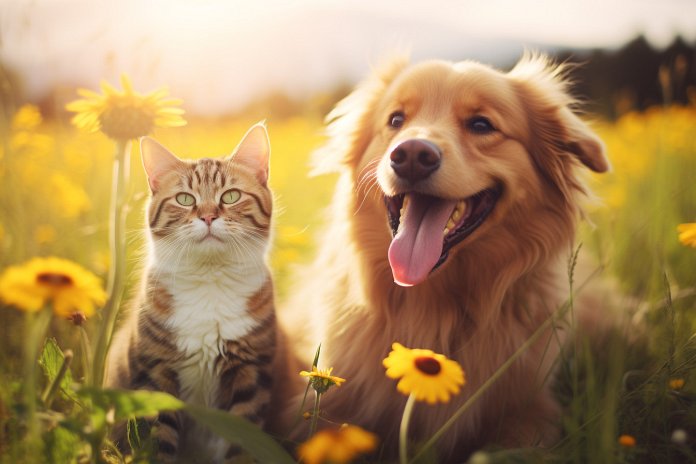
Dogs and cats are very different creatures. Dogs are social and trainable pack animals, while cats are independent and territorial. They have different body language and make different sounds. In the past, it was believed that cats and dogs couldn’t get along, but many families successfully bring them together. This raises questions about their ability to communicate and whether dogs can understand cats.
Signs of Dog-Cat Communication
Dogs and cats communicate through body language. It’s important to consider the context and the animal’s personality when interpreting their behavior. Different tail wags, ear positions, body postures, and mouth movements convey different messages. Dogs wag their tails when they’re relaxed or friendly, while cats use their tails to signal confidence or aggression. Dogs have open mouths when relaxed, while cats have closed mouths. Dogs have their ears back when approachable, while cats have their ears up. Cats may give head bumps and knead to show affection.
Body Language
Some signs that dogs may be communicating with cats include wagging tails, low tail carriage, ears back, tongues hanging out, and other behaviors such as freezing, sniffing each other, crouching, and making low noises.
The History of Dog-Cat Communication
Dogs and humans have similar brain structures and process emotions in similar ways. Dogs have been shown to understand human signals and respond emotionally. It’s possible that dogs can also understand the signals of the animals they live with, such as cats. Dogs have evolved to understand human emotions, so it’s not surprising that they can pick up on the signals of other animals.
The Science of Dog-Cat Communication
Researchers have been studying the relationship between cats and dogs and how they communicate. They found that dogs and cats in close proximity are evolving to better communicate with each other. In their study, two-thirds of homes reported a peaceful environment, 25% had indifferent animals, and 10% had aggression and fighting. Dogs and cats have different signals for friendliness and aggression, but those who live well together seem to have developed their own communication system. For example, dogs in cat-compatible homes greet cats by sniffing noses instead of rears. It was also found that adopting a cat before a dog, when both are young, increases the likelihood of them living well together.
Training Your Dog and Cat to Live Together
If you already have a dog and want to introduce a cat, it’s important to consider the breed, age, and temperament of your dog. If your dog has a history of aggression towards cats, it may not be a good idea to bring a cat into the environment. To introduce them, start by allowing them to get acquainted with each other’s scents and then gradually introduce them in controlled environments. Always supervise them until you are confident they will be peaceful with each other.
Conclusion
Dogs and cats have different ways of communicating, but with time and careful introductions, they can live harmoniously together. Understanding their body language and providing a safe environment for both pets are key to successful dog-cat relationships.
“In the world of pets, dogs and cats may speak different languages, but they have the ability to understand each other in their own unique way.”

Tips & Things to Know
1️⃣ Understand the different body language of dogs and cats: Dogs and cats communicate with their body language, and it’s important to understand the differences between them. For example, a wagging tail in a dog may indicate friendliness, while in a cat, it may signal aggression. Pay attention to their tails, ears, body postures, mouths, and heads to interpret their messages accurately.
2️⃣ Look for signs of communication between your dog and cat: Dogs and cats who live together may have the ability to understand each other’s signals. Watch for signs such as tail movements, body freezing, sniffing each other, crouching, and low noises. These behaviors can indicate that your pets are communicating and establishing their own communication system.
3️⃣ Take steps to introduce your dog and cat properly: If you’re bringing a new cat into a household with a dog, it’s important to introduce them slowly and carefully. Start by allowing them to get acquainted with each other’s scents, then progress to supervised face-to-face meetings. Use a baby gate or keep the dog on a leash during introductions to maintain control. Always supervise their interactions until you’re confident they will be peaceful with each other.
Frequently Asked Questions, Answered ✅
1. How do dogs and cats communicate with each other?
– Dogs and cats communicate with each other through body language, such as tail movements, ear positions, and mouth postures. They have different signals to convey their feelings of friendliness and aggression.
2. Can dogs understand cats?
– Dogs have the capacity to understand cats to some extent. Dogs who live with cats may be able to read the signals of the cats and vice versa. However, it is important to consider the context and the personality of the animals when interpreting their behavior.
3. What are some signs of communication between dogs and cats?
– Some signs of communication between dogs and cats include tail movements from both animals, body freezing, sniffing each other, crouching, and making low noises.
4. How do dogs and cats differ in their body language?
– Dogs and cats have different body languages. For example, a relaxed dog will have a slightly open mouth with their tongue hanging out, while a relaxed cat will have a closed mouth. Dogs wag their tails to the right when friendly, while cats have different messages depending on the position and movement of their tails.
5. Is it possible to train dogs and cats to live together?
– It is possible to create a harmonious home with both dogs and cats, even if they are introduced at different times. It is important to consider the breed, age, and temperament of the dog, and to introduce them slowly and supervise their interactions until they can be trusted to be peaceful with each other.